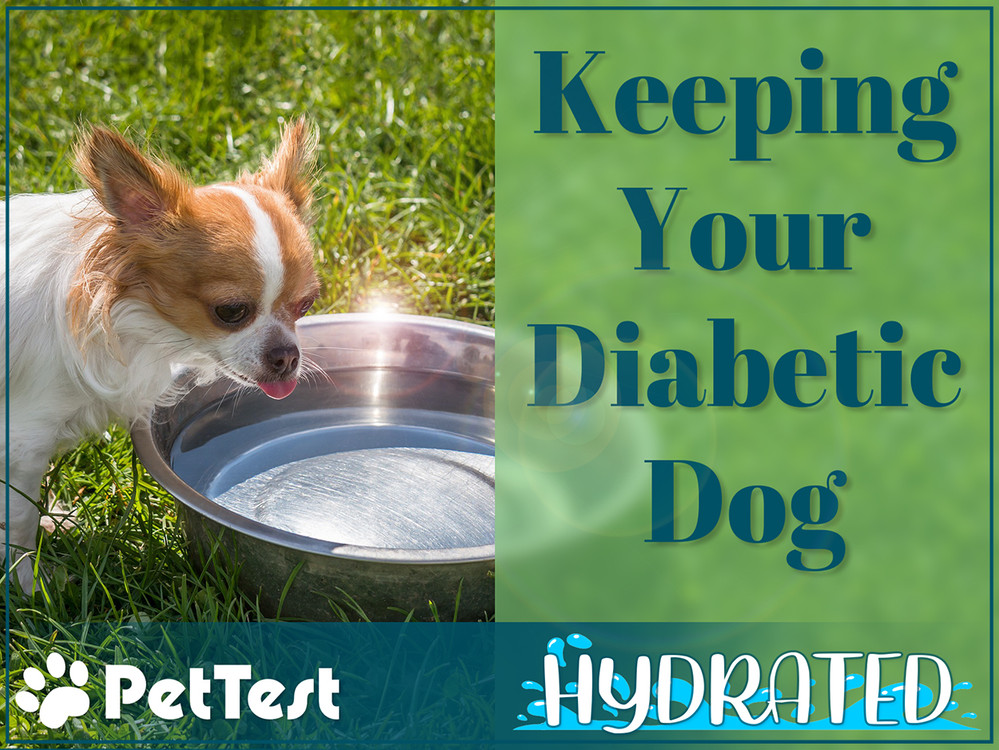Keeping Your Diabetic Dog Hydrated
Today we are revisiting the topic of hydration. Dehydration is a real concern for all animals in the summertime, but for our Diabetic pups, it’s a huge concern. Summer heat is upon us and that means that precautions need to be taken with our pups. In the post about Season Changes, we touched on insulin needs with the change of seasons; today we address a specific issue that is tied to summertime.
For us humans, we know that we are dehydrated when we are drinking a bunch of water but don’t seem to be going to the bathroom much. So, we drink more water and it all evens out. This is not the case for our Diabetic pups. I know that you’re thinking, but he/she is drinking and peeing a ton so he/she can’t possibly be dehydrated. Not so… Our “sugar babies” can easily be dehydrated even when they are drinking and urinating a lot.
Dr. Joi Sutton explains it this way, “The kidney threshold for glucose is somewhere between 180 and 300 mg/dL for dogs and cats. It varies from one pet to another, with cats usually having a higher threshold than dogs. When the blood glucose goes higher than the kidney glucose threshold, it makes it extremely difficult for the kidneys to pull fluid back. Kidneys are very active organs. They excrete then reabsorb fluid. What fluid is left after kidneys filter the blood is called urine. When the blood glucose exceeds the kidney threshold for sugar, a diabetic will continue to pee out dilute urine even if the patient is dehydrated.”
What does that mean? It means that you can’t gauge whether your pup is dehydrated by the amount of water that they consume and eliminate. When BG (blood glucose) is high, the kidneys can’t keep enough fluid in the body to keep it properly hydrated. So, watch for these symptoms:
- Loss of skin elasticity
- Loss of appetite
- Vomiting with or without diarrhea
- Lethargy
- Panting
- Sunken dry looking eyes
- Dry nose
- Dry sticky gums
- Thick saliva
My “go to” tests were to grab Max at the scruff of the neck and see how long it took for the skin to return to normal. The other easy one was to lift his lip and to check the color and “texture” of his gums. If the gums are light pink and feel tacky or sticky to the touch, when you press on the gums and it takes a while for the area where your finger was to return to a healthy pink color, that is a sign of dehydration. I could also tell that he was getting a little “dry” when his blood was sluggish when I tested. A well hydrated pup is not stingy with their blood for a BG (blood glucose) test. So, out came the parmesan cheese and the “special bowl” for lots of extra drinking.
The best way to deal with dehydration is to try to prevent it from happening in the first place. Make sure that you have lots of water bowls around the house and that they are filled with cool clean water at all times. Especially if you work outside the home, you want to be sure that even if one bowl gets knocked over, there are plenty of other sources of water for your pup. Also, make sure that you have water outside even if you only let your pup out briefly. You can put a plastic bowl with fresh water in the freezer and make a big ice cube to go in the outside water bowl. It will melt and fill the bowl and provide a source of cool/cold water to refresh your pup.
If you are taking walks during the summer, make sure that you are going very early in the morning or later in the evening when it is cooler. This is also advised so that your pup’s paws aren’t subjected to hot pavement and the risk of blistering. In summertime add a water bottle and portable bowl to your “walk kit” mentioned in the post about exercise.
If your pup is exhibiting signs of dehydration, likely a vet visit is in order. They will administer subcutaneous or IV fluids to re-hydrate your pup quickly and replace electrolytes that have been lost. Please don’t ignore the signs of dehydration as left untreated; it can lead to organ damage or even failure. When it comes to dehydration, always err on the side of caution and encourage your pup to drink!
Notice that for most of the products or groups that I mention, the text is linked to a website that you can purchase that item or a link to join the group mentioned. Just click on the colored text (red or blue, depending what device you are on) and it should take you right to the item or group. If you have any thoughts or ideas for topics that you’d like to see covered here, please feel free to comment below or send me an email at NancyForPetTest@pharmasupply.com. As always, please “like” this blog post or any of the others that have helped you or just refreshed your memory. Look for new posts every Tuesday!
Until next time…

